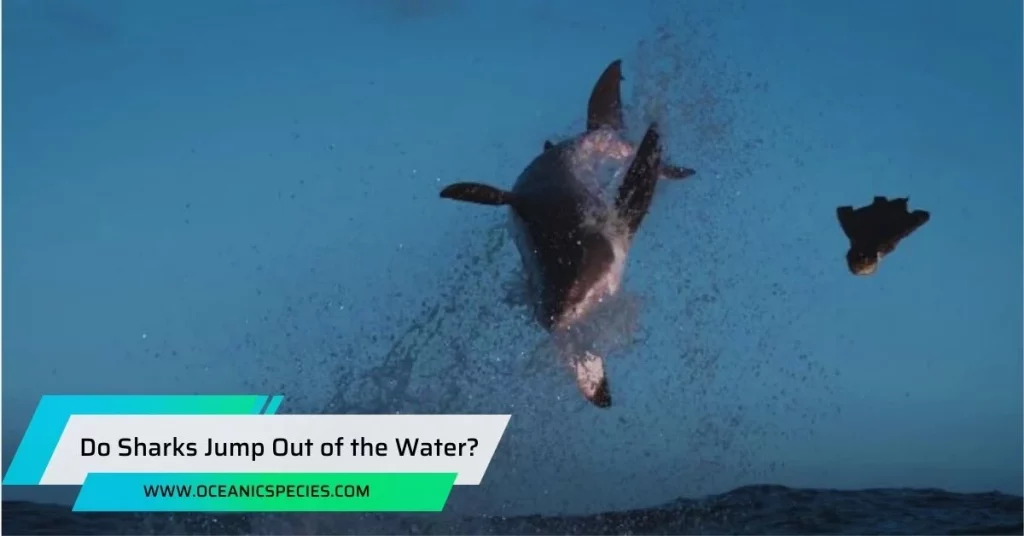Sharks can jump out of the water. We will explore the phenomenon of sharks leaping and discuss the reasons behind this behavior.
Sharks are known for their impressive swimming abilities and agility in the water. While they primarily reside in the ocean, it is not uncommon for sharks to jump out of the water. This behavior, known as breaching, is often seen in certain shark species such as great whites and mako sharks.
Breaching serves various purposes for sharks, including hunting, evading predators, or removing parasites. By propelling themselves out of the water, sharks can surprise their prey from below or escape from potential threats. Additionally, breaching allows sharks to regulate body temperature, as the air is usually cooler than the surrounding water.
Myth Or Reality: Understanding Shark Behavior
While sharks are indeed capable of jumping out of the water, it is not a behavior that is exhibited by all shark species. Factors such as feeding habits, hunting strategies, natural instincts, and environmental conditions play a pivotal role in determining whether a shark will breach the water’s surface.
Factors Influencing Shark Behavior
Shark behavior is influenced by various factors, including their feeding habits, hunting strategies, natural instincts, and environmental conditions. Understanding these factors can help shed light on whether sharks actually jump out of the water or if it is merely a myth.
Feeding Habits And Hunting Strategies
Sharks are opportunistic predators that primarily feed on live prey, such as fish, seals, and even other sharks. Some species of sharks employ unique hunting strategies, such as breaching, where they launch themselves out of the water to surprise their prey from below. While breaching is observed in certain shark species, it should be noted that not all sharks exhibit this behavior. It is primarily seen in larger species, such as great white sharks and mako sharks.
Natural Instincts And Environmental Conditions
Sharks have a strong natural instinct to explore their surroundings and investigate potential food sources. This instinct often leads them to breach the water’s surface. Environmental factors, such as the presence of obstacles or aggregations of prey near the surface, can also influence shark behavior and increase the likelihood of breaching. Additionally, some studies suggest that sharks may breach the water as a means of communication or to remove parasites from their bodies.
Gravity-Defying Leaps: Why Sharks Jump Out Of The Water

Sharks are known for their incredible leaping ability, often seen breaching the surface of the water in a gravity-defying display. This behavior has captured the curiosity and awe of both researchers and shark enthusiasts alike. But why do sharks jump out of the water?
Let’s explore the reasons behind this fascinating phenomenon.
Breaching Behavior Explained
- Sharks breach to catch prey: One possible reason for this behavior is hunting. By launching themselves out of the water, sharks can surprise their prey, giving them a higher chance of success. This tactic is especially effective when targeting fast-swimming, agile prey such as seals or dolphins.
- Breaching for communication: Another explanation could be communication. Sharks may breach to communicate with other sharks in their vicinity. This behavior could signal territorial boundaries, attract a mate, or establish dominance.
- Parasite removal: Sharks sometimes breach to remove parasites from their bodies. Jumping out of the water causes a temporary change in water pressure, which may dislodge these unwelcome hitchhikers.
Predatory Techniques In Action
- Ambush attacks: Breaching allows sharks to launch a surprise attack on their prey from below. By gaining momentum and launching themselves out of the water, they increase their chances of catching their unsuspecting victims off guard.
- Strategic positioning: When breaching, sharks can reposition themselves for a better angle of attack. This gives them the advantage of a swift, unexpected strike, maximizing their chances of a successful kill.
- Efficiency in hunting: Aerial attacks can be a more energy-efficient method of hunting for certain shark species. By breaching, sharks expend a burst of energy to quickly close the distance between themselves and their prey, ensuring a higher success rate.
Benefits And Advantages Of Airborne Attacks
- Enhanced visibility: Jumping out of the water offers sharks a vantage point from which they can better scan the surrounding area for potential prey. This increased visibility increases their chances of locating and targeting their next meal.
- Increased hunting success: Breaching provides sharks with an opportunity to overcome the evasive maneuvers that prey may employ in the water. By leaping out of their element, sharks can create surprise and confusion, effectively reducing their prey’s chances of escape.
- Adaptation to changing environments: Sharks that exhibit breaching behavior have adapted to capitalize on opportunities in different environments. Whether it’s hunting in shallow waters or navigating oceanic currents, these agile predators have developed the ability to extend their range by employing this unique tactic.
The Science Behind Shark Leaps: Anatomy And Physics
Shark leaps are a remarkable display of nature’s ingenuity, blending the efficiency of their anatomy with the laws of physics. Understanding the role of muscle strength, speed, hydrodynamics, and energy conservation provides us with a glimpse into the remarkable world of these magnificent creatures.
Role Of Muscle Strength And Speed
Sharks possess powerful muscles that enable them to generate immense strength and speed. These factors play a crucial role in their ability to launch themselves out of the water. The caudal fin, or tail fin, is the primary source of propulsion for sharks. It consists of powerful muscles that contract and generate thrust, propelling the shark forward with great force. The muscles responsible for shark leaps are known as the epaxial muscles, which are located along the shark’s back. These muscles contract rapidly, providing the necessary upward force to lift the shark out of the water. A shark’s speed is also a contributing factor to its leaping ability. The faster the shark swims, the greater the force it can exert against the water, propelling it higher into the air.
Hydrodynamics And Buoyancy Effects
Hydrodynamics, the study of fluid motion, plays a significant role in shark leaps. By understanding the principles of hydrodynamics, we can gain insights into how sharks are able to break the surface tension of the water and propel themselves into the air. When a shark swims towards the surface, water resistance increases, creating an upward force on the shark’s body. This force counteracts the downward pull of gravity, effectively assisting the shark in achieving lift. Sharks possess a unique feature known as a heterocercal tail, which means that the upper lobe is larger than the lower lobe. This tail design helps sharks maintain stability during a leap, enabling them to stay airborne for longer durations. The streamlined shape of a shark’s body further enhances its ability to cut through the water with minimal resistance, allowing for efficient propulsion and increased leaping potential.
Conservation Of Energy And Momentum
The laws of physics, specifically the principles of energy conservation and momentum, play a pivotal role in a shark’s leap. These principles govern the transfer of energy and motion from the shark to its surroundings. Conservation of energy states that the total energy of a system remains constant unless acted upon by external forces. In the case of a shark leap, the potential energy gained from swimming upwards is converted into kinetic energy, launching the shark out of the water. Conservation of momentum dictates that the total momentum of a system is conserved unless acted upon by external forces. As the shark propels itself upward, it exerts a downward force on the water, causing it to push against the shark with an equal and opposite force, propelling it into the air. By effectively utilizing these principles, sharks maximize their leaping capabilities while minimizing the energy expended, allowing them to conserve their strength for hunting and other essential activities.
Debunking Misconceptions: Rare Occurrences Vs. Popular Beliefs
By separating fact from fiction and understanding the statistical reality, we can appreciate and respect sharks as fascinating creatures without succumbing to unnecessary fear. Remember, enjoying the wonders of the ocean responsibly is the key to maintaining a harmonious coexistence with these magnificent predators.
Common Myths About Sharks’ Aerial Attacks
Myth: Sharks frequently jump out of the water to attack.
In reality, aerial attacks by sharks are extremely rare occurrences.
Myth: All shark species have the ability to jump out of the water.
The truth is that only a few select species, such as the great white shark and the mako shark, have been observed jumping out of the water during hunting or feeding behavior.
Myth: Sharks jump out of the water to attack humans intentionally.
Contrary to popular belief, these rare instances of aerial attacks are not specifically targeted at humans. Sharks primarily breach the surface to catch prey, such as seals or fish, that may be swimming near the surface.
Media Hype Vs. Statistical Reality
Misleading media portrayals often perpetuate the fear of shark attacks. However, it’s important to consider the statistical reality in order to gain a more accurate understanding:
- Statistically, shark attacks are extremely rare.
- According to the international shark attack file, the odds of being bitten by a shark are about 1 in 11.5 million.
- Despite the sensational headlines, shark-related fatalities are even rarer.
- On average, fewer than ten people die each year globally as a result of shark attacks.
- It is crucial to remember that sharks play a vital role in marine ecosystems.
- By maintaining a healthy balance in the ocean’s food chain, they help preserve the biodiversity of our oceans.
Understanding Probability And Risk Assessment
When it comes to assessing the risk associated with shark attacks, it’s important to consider probability and understand how it impacts our perception:
- Probability is key in risk assessment.
- While the idea of a shark leaping out of the water may capture our imagination, the statistical likelihood of it happening to any individual is incredibly low.
- The fear of shark attacks often stems from media sensationalism.
- Media coverage tends to focus on rare, dramatic events, creating an exaggerated perception of risk.
- Engaging in ocean activities safely can help mitigate the minimal risk.
- Following guidelines, such as avoiding swimming at dawn or dusk when sharks are more active, can further reduce the already slim chance of encountering a shark.
Remarkable Examples: Notable Shark Species With Leaping Abilities
It may seem like something out of a horror movie, but the truth is, some shark species do possess the ability to leap out of the water. In this section, we will explore some of the most remarkable examples of shark species with impressive leaping abilities.
Great White Sharks: Apex Predators Of The Ocean

Known as the kings of the ocean, great white sharks are undoubtedly the most famous of all shark species. These apex predators can reach lengths of up to 20 feet and weigh over 2,000 kilograms. Great white sharks are known for their incredible power and speed, and they can breach the water’s surface with astonishing force. They use their muscular bodies and powerful tails to propel themselves out of the water, often catching their prey by surprise from below. This behavior is especially common when hunting seals, as they launch themselves out of the water to catch their agile prey off guard. Witnessing a great white shark leaping out of the water is a truly awe-inspiring sight.
Mako Sharks: The Speed Demons
Considered the fastest of all shark species, mako sharks are built for speed. They have streamlined bodies and a large caudal fin, which allows them to swim at incredible speeds, reaching up to 31 miles per hour. Makos are known to breach the water’s surface in spectacular fashion, often launching themselves into the air while hunting or when trying to escape from potential threats. These high-flying acrobatics are not only visually stunning but also reflect the agility and power of these impressive creatures.
Spinner Sharks: The Aerial Acrobats
Spinner sharks are aptly named for their unique behavior of spinning through the air. These sharks have a long, slender body and are known for their ability to leap out of the water and spin multiple times before re-entering the ocean. The spinning motion is believed to be a hunting technique, disorienting schools of fish and making them easier to capture. It is truly remarkable to witness these aerial acrobats in action, as they twist and turn through the air with remarkable grace and precision.
Ecological Significance: The Impact Of Shark Breaching Behavior
Shark breaching behavior is not simply a spectacle to be admired. It has significant ecological significance, from regulating prey populations and influencing prey behavior to conservation implications and environmental concerns. Understanding the impacts and importance of shark breaching behavior is crucial for conserving these fascinating creatures and maintaining the delicate balance of our oceans.
Role In Ecosystem Balance
Sharks help maintain a delicate balance within marine ecosystems by regulating prey populations. Breaching behavior is one way they hunt and capture their prey. When sharks breach, they often target schools of fish near the water’s surface. This predatory behavior helps control the population of certain species, preventing them from overpowering others and upsetting the natural balance. By keeping prey populations in check, sharks contribute to the overall health and stability of the ecosystem. Their role as top predators is essential for maintaining biodiversity and ensuring the survival of other marine species.
Influence On Prey Behavior And Distribution
The mere presence of sharks and their breaching behavior can greatly influence the behavior and distribution of prey species. The fear and avoidance of predation drive prey to modify their behaviors and seek safer habitats. Prey species may form tighter schools or change their swimming patterns to reduce the risk of being singled out by a breaching shark. This altered behavior can have significant impacts on the overall dynamics of the ecosystem. Additionally, the fear of being attacked by sharks can cause prey species to avoid specific areas altogether, leading to changes in the distribution and abundance of other marine organisms. This ripple effect can have cascading consequences throughout the food web.
Conservation Implications And Environmental Concerns
The decline of shark populations due to overfishing and habitat destruction poses serious conservation concerns. If sharks were to disappear from the oceans, the ecological balance could be severely disrupted. Preserving and protecting shark populations is crucial for maintaining healthy marine ecosystems. By regulating prey populations, sharks contribute to the stability and resilience of these fragile systems. Furthermore, shark breaching behavior has become a popular attraction for ecotourism, benefiting local economies and raising awareness about the importance of shark conservation. Encouraging sustainable ecotourism practices can help promote the preservation of these magnificent creatures and the ecosystems they inhabit.
Human Encounters: Safety Measures And Precautions
While sharks are indeed capable of breaching the water’s surface, it is not a behavior aimed at humans. By understanding shark attack statistics, adopting strategies to minimize potential encounters, and supporting responsible tourism and conservation practices, we can ensure a safer and more harmonious coexistence with these magnificent creatures of the sea.
Shark Attack Statistics And Risk Assessment
Understanding the statistics and risks associated with shark attacks is crucial for anyone planning to spend time near the ocean. Here are some key points to consider:
- Shark attacks are relatively rare, with only a small number of incidents reported worldwide each year.
- The international shark attack file (ISAF) records data on shark attacks and provides valuable insight into the frequency and severity of these encounters.
- While it’s important to acknowledge the risks, it’s equally important to keep in mind that millions of people enjoy water activities without ever encountering a shark.
Strategies For Minimizing Potential Encounters
When it comes to minimizing the potential for shark encounters, there are several strategies individuals can adopt. Here are some effective ways to reduce the risk:
- Always swim, surf, or engage in water activities in groups rather than alone. Sharks are more likely to target solitary individuals.
- Avoid swimming during dawn and dusk, as these are the times when sharks are more active.
- Pay attention to warning signs, flags, or advisories posted at beaches. These are in place to alert beachgoers about any potential shark activity.
- Avoid areas where fishing is taking place, as discarded bait or fish blood can attract sharks.
Responsible Tourism And Conservation Practices
Responsible tourism and conservation practices are essential for maintaining the delicate balance between human enjoyment of the ocean and the preservation of shark populations. Consider the following:
- Support local organizations and initiatives that focus on shark conservation, research, and education.
- Choose tour operators and dive shops that abide by responsible shark interaction guidelines, such as those outlined by organizations like project aware.
- Educate yourself about the importance of sharks in the ecosystem and share this knowledge with others to dispel common misconceptions and promote conservation efforts.
Frequently Asked Questions
How High Can Sharks Jump Out Of The Water?
Sharks can jump up to 10 feet out of the water, although most breaches are usually around 5 to 10 feet.
Why Do Sharks Jump Out Of The Water?
Sharks jump out of the water for various reasons, including hunting prey near the surface, evading predators, or even just out of curiosity.
Can Sharks Jump Onto Boats?
While it’s rare, there have been instances where sharks have jumped onto boats. However, such incidents are extremely uncommon.
Are Shark Jumps Dangerous To Humans?
Shark jumps are generally not dangerous to humans unless they happen to be in close proximity to the jumping shark. However, such instances are very rare.
Conclusion
While the notion of sharks jumping out of the water may seem like a thrilling and terrifying prospect, it is largely a rare occurrence. While certain species, such as the great white shark, have been known to breach the surface in pursuit of prey, this behavior is not common to all sharks.
Sharks primarily swim and hunt underwater, utilizing their incredible speed and agility to ambush their prey. Jumping out of the water requires a significant amount of energy and is typically only done in specific circumstances. Additionally, the media often sensationalizes these events, leading to misconceptions about the frequency and danger of shark jumps.
It is important to remember that sharks are magnificent creatures that play a vital role in maintaining the health of our oceans. By understanding their behaviors and debunking myths, we can ensure both our safety and their conservation.





